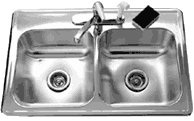Products covered by the new lead leaching requirements include kitchen, bar, and lavatory faucets; drinking fountains; water coolers, residential refrigerator ice makers and water dispensers; and supply stops and endpoint control valves.
 The 1996 amendments to the Safe Drinking Water Act (SDWA) required the U.S. Environmental Protection Agency (EPA) to establish a performance standard to govern the leaching of lead from endpoint devices intended to dispense water for human consumption. The EPA selected Section 9 of ANSI/NSF
Standard 61: Drinking Water System Components-Health Effects as this performance standard.
The 1996 amendments to the Safe Drinking Water Act (SDWA) required the U.S. Environmental Protection Agency (EPA) to establish a performance standard to govern the leaching of lead from endpoint devices intended to dispense water for human consumption. The EPA selected Section 9 of ANSI/NSF
Standard 61: Drinking Water System Components-Health Effects as this performance standard.
Prior to the 1996 amendments, the Safe Drinking Water Act required faucets and other plumbing fixtures to contain no more than 8 percent lead. The 1996 amendments retained the 8 percent lead content requirement and further mandated that faucets, drinking fountains and other drinking water dispensing devices must now also meet the performance-based lead leaching requirements of ANSI/NSF Standard 61, Section 9.
Section 1417(a)(3) of the Safe Drinking Water Act makes it unlawful for any pipe or plumbing fitting or fixture that is not "lead free" to be introduced into commerce after August 6, 1998. The EPA interprets this to mean that products not complying with the lead requirements of the Act cannot be sold or distributed by manufacturers or distributors. Because the statute does not distinguish between wholesale and retail sales, the EPA believes it includes sale and distribution of products from existing inventories, as well as initial product offerings. The agency also applies this interpretation to products installed by contractors, even if the product was purchased before August 6, 1998. This means that potable water products certified to both ANSI/NSF Standard 14 and ANSI/NSF Standard 61 also meet Section 1417 (a) (3) of the SDWA. ANSI/NSF Standard 61, Section 9, covers endpoint devices intended to dispense water for human consumption. An endpoint device as defined by the standard is "any single device typically installed within the last one liter of the water distribution system of a building." Products covered by the new lead leaching requirements include kitchen, bar, and lavatory faucets; drinking fountains; water coolers; residential refrigerator ice makers; and water dispensers, and supply stops and endpoint control valves.
Pipe, fittings and in-line devices such as water meters and gate valves, which are not endpoint devices, are covered by other sections of ANSI/NSF Standard 61, and have lead extraction requirements comparable to Section 9. The Safe Drinking Water Act also requires these products to contain less than 8 percent lead.
Bath and shower valves, bidets, drains, backflow preventers, garden hose outlets, and utility and laundry tub faucets do not have to meet the requirements of NSF Standard 61 because these products are not routinely used for drinking water. Such products are evaluated for performance under the NSF Mechanical Plumbing Products Certification Program.
Although ANSI/NSF Standard 61 covers all drinking water devices and all contaminants with the potential to leach out of these devices into drinking water, the Safe Drinking Water Act only requires end point plumbing devices to comply with the lead leach requirements of Section 9.
ANSI/NSF Standard 14 requires all potable water plastics and plumbing system components (such as metal fittings used with plastic tubing) to comply with health effects requirements of ANSI/NSF Standard 61.
Drinking water treatment units and auxiliary faucets sold with these devices are not required to comply with the lead leach requirements, but they must show compliance with the 8 percent lead content requirement. NSF Standards 42, 53, and 58 specify the aesthetic and health effects requirements for these products.
The new "lead free" requirements, which went into effect last August, only require "compliance" to the NSF Standard, not independent third-party certification. Even so, most U.S.-based faucet manufacturers and some European and Asian manufacturers have opted to have their products certified by NSF International. These products bear the NSF Mark on the product packaging indicating certification to ANSI/NSF Standard 61, Section 9. Listings of certified products are online at the NSF Web site.
Under Standard 61, products are exposed to a special extractant water for three weeks. Because the EPA establishes safe levels for many contaminants, including lead, the analysis must ensure that the concentration found in the extractant water is below regulated levels.
Standard 61 covers everything from the equipment used to treat and store water at a water treatment plant to the distribution pipe, valves and devices in a municipal distribution system, and all the plumbing products in buildings.
Although Standard 61 sets no product performance criteria, several product performance standards reference NSF Standard 61 for the toxicological safety of drinking water materials. Currently 29 states require treatment plant equipment and distribution system components to comply with NSF Standard 61. Most U.S. model plumbing codes reference NSF Standard 61 for plumbing products.
For more information about ANSI/NSF Standard 61 and the lead free requirements of the Safe Drinking Water Act, contact Peter Greiner at (800) NSF-MARK, by fax at (734) 769-0109 or by e-mail. Back to Top
